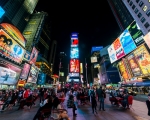Let There Be Light!
>
Light is all around us, and it increasingly affects our daily lives. For example, we have started to carry personal light sources around with our smartphones, and in our homes many electrical machines now utilize light to display information and simply to appear more attractive. In a larger context, architecture and cities have also developed a new dimension with the advent of electrical lighting for work and entertainment. Inspired by the central role of light for our culture and technology, the United Nations has proclaimed 2015 as the “International Year of Light and Light-based Technologies” (IYL2015). With IYL2015 the UN wants to raise the awareness of the importance of light and optical technologies in our lives, our future and the development of society.
Light is a key element in architecture. For centuries the sun was primarily used to simply illuminate stone facades, but glass opened a path for interior spaces with increased brightness and a feeling of openness. With the introduction of electrical light and sophisticated optical technology engineers have looked for ways to copy the qualities of natural light, from diffuse illumination to accentuation. They were driven by the vision to create an attractive atmosphere within buildings and to improve life in the working environment. Through the rapid innovation of lamps with increasing light outputs we have already moved towards the point where the goal of avoiding glare is as relevant as the light itself.
With contemporary LED technology we possess a building element where tiny software driven pixels can be flexibly embedded in furniture, interior surfaces or even facades, changing their intensity and colour dynamically. Thereby building surfaces have started to turn into self-luminous media elements for aesthetic or commercial storytelling. We can grasp the idea of living within dynamic screens that never rest. Light is often taken for granted and only through its absence do we become aware of the overall influence of illumination.
Due to the abundance of light today we have lost the beauty of the night. Particles in the sky that reflect urban light emissions reduce the opportunity to enjoy the stars at night. Not only does this “sky glow” affect people, particularly astronomers, but it also affects other organisms, such as birds that are oriented by stars. In addition, medical scientists have pointed out the health risk that night shift worker face when their circadian rhythms are disrupted.
Hence, more research is necessary to understand the dependencies between light and health in order to find adequate answers for challenging living and working situations. The wide perspective of the IYL2015 will ensure that the various dimensions of light, culture, technology and energy will be included.
 ARCHDAILY
ARCHDAILY


